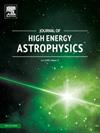Role of internal space correlations in the dynamics of a higher-dimensional Bianchi type-I universe: Shear scalar and Hubble parameter perspectives
IF 10.5
4区 物理与天体物理
Q1 ASTRONOMY & ASTROPHYSICS
引用次数: 0
Abstract
We investigate exact solutions of the Einstein field equations in higher-dimensional, spatially homogeneous Bianchi type-I spacetimes, introducing a real parameter λ that correlates the expansion rates of external and internal spaces. Extending beyond Robertson–Walker spacetime, our approach includes positive and negative correlations, suggesting a broader and isotropic/anisotropic cosmological model space. Positively correlated dimensions manifest as a cosmological constant at late times, while at early times, they mimic stiff-fluid-like dark energy that dilutes faster than radiation, paralleling early dark energy models. This suggests a pathway for alleviating the Hubble tension by tailoring higher-dimensional dynamics to reduce the sound horizon. When anisotropic expansion is allowed, these models achieve isotropization more efficiently than predicted by Wald's cosmic no-hair theorem. Negative correlations, in contrast, yield a higher-dimensional steady-state universe where the shear scalar remains constant, effectively emulating a negative cosmological constant. These distinct behaviors arise from a simple signature change: positive correlation accelerates shear scalar decay, while negative correlation stabilizes it. We demonstrate that the solutions admit analytic continuation from the Lorentzian to Euclidean regime (), revealing a wormhole-like topology that connects two asymptotic regions via a throat, with .
内部空间关联在高维Bianchi - i型宇宙动力学中的作用:剪切标量和哈勃参数视角
我们研究了高维空间齐次Bianchi i型时空中爱因斯坦场方程的精确解,引入了一个与外部空间和内部空间的膨胀率相关的实参数λ。超越罗伯逊-沃克时空,我们的方法包括正相关和负相关,提出了一个更广泛的各向同性/各向异性宇宙模型空间。正相关的维度在后期表现为宇宙常数,而在早期,它们模拟了比辐射稀释得更快的硬流体状暗能量,与早期暗能量模型相似。这暗示了一种通过调整高维动态来减少声视界来缓解哈勃紧张的途径。当允许各向异性膨胀时,这些模型比沃尔德宇宙无毛定理预测的更有效地实现了各向同性。相反,负相关会产生一个更高维度的稳态宇宙,其中剪切标量保持不变,有效地模拟了一个负的宇宙常数。这些不同的行为源于一个简单的特征变化:正相关加速了剪切标量衰减,而负相关稳定了剪切标量衰减。我们证明了解允许从洛伦兹域到欧几里得域(t→−iτ)的解析延拓,揭示了一个类似虫洞的拓扑结构,它通过λ→−λ的喉道连接两个渐近区域。
本文章由计算机程序翻译,如有差异,请以英文原文为准。
求助全文
约1分钟内获得全文
求助全文
来源期刊

Journal of High Energy Astrophysics
Earth and Planetary Sciences-Space and Planetary Science
CiteScore
9.70
自引率
5.30%
发文量
38
审稿时长
65 days
期刊介绍:
The journal welcomes manuscripts on theoretical models, simulations, and observations of highly energetic astrophysical objects both in our Galaxy and beyond. Among those, black holes at all scales, neutron stars, pulsars and their nebula, binaries, novae and supernovae, their remnants, active galaxies, and clusters are just a few examples. The journal will consider research across the whole electromagnetic spectrum, as well as research using various messengers, such as gravitational waves or neutrinos. Effects of high-energy phenomena on cosmology and star-formation, results from dedicated surveys expanding the knowledge of extreme environments, and astrophysical implications of dark matter are also welcomed topics.
 求助内容:
求助内容: 应助结果提醒方式:
应助结果提醒方式:


